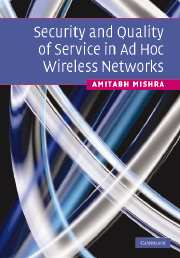2 - Wireless security
Published online by Cambridge University Press: 26 February 2010
Summary
Wireless networks are typically divided into three classes depending on their range of transmissions. We have personal area networks (PANS) that have a very low transmission range, of the order of several meters; Bluetooth happens to be the representative network or technology when wireless personal area networks are mentioned. On a slightly larger transmission scale, of the order of 100–200 meters, we have wireless local area networks (LANs), known as 802.11 or WiFi, which are very well deployed all over the world. The personal area and local area networks have been primarily designed for indoor applications. Networks that have transmission in the range of several kilometers are known as wireless wide area networks (WANs), and cellular networks of different vintages are prime examples of such networks. So any discussion of security in a wireless environment will not be complete unless the proposed security schemes for these three distinct networks are examined. In this chapter, I briefly go over the security schemes of wireless PAN, LAN, and WAN networks. For readers interested in knowing more about these topics, appropriate references are highlighted. I begin this chapter by discussing WiFi security, followed by cellular network security, and concluding with the security of personal area networks.
Wireless local area networks (IEEE 802.11) security
Introduction
A wireless local area network (WLAN) is a flexible data communication system implemented as an extension to, or as an alternative to, a wired LAN. Wireless local area networks transmit and receive data over the air via RF technology, minimizing the need for any wired connections, and in turn, combining data connectivity with user mobility.
- Type
- Chapter
- Information
- Publisher: Cambridge University PressPrint publication year: 2008



